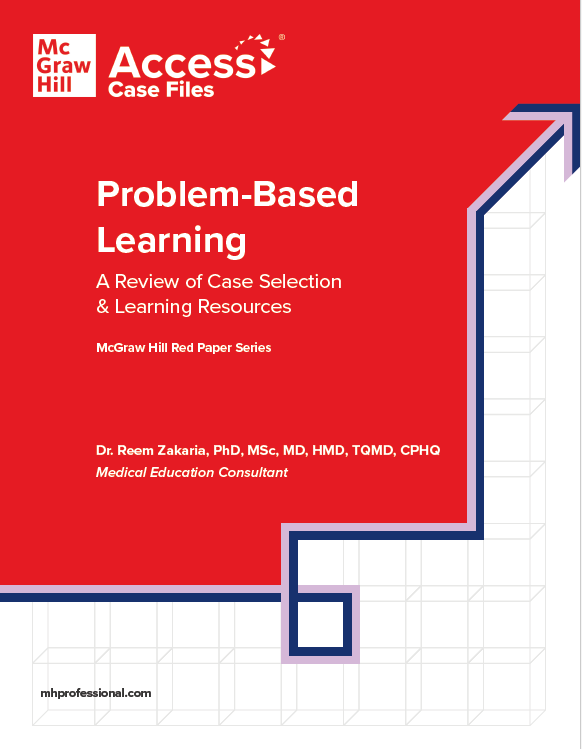Problem-Based Learning: What It Is and How It Can Benefit Medical Students
Problem-Based Learning: What It Is and How It Can Benefit Medical Students
Problem-based learning (PBL) has been an integral part of medical curricula for decades. So what are the advantages of problem-based learning, what does it involve, and which skills is it designed to develop, and how can it be implemented in your institution?
What is problem-based learning?
Problem-based learning is a pedagogical approach in which students gain knowledge and acquire skills by engaging with a medical case (real-world or hypothetical) in small groups. While it is now applied in various fields, it originates from the teaching of medicine.
The importance of problem-based learning is to aid the development of long-term retention of learning and overcome the gap between theoretical classroom study and the practical application of what they learn. It achieves this by giving students ownership of their own learning and boosting their skills in several key areas.
For medical students, PBL offers an opportunity to gain a comprehensive understanding of a patient's condition. Through active engagement, they collaboratively tackle real-world medical challenges and complex questions within their PBL groups. This method fosters a dynamic learning environment where student can explore how diseases manifest, underlying etiology, potential treatment approaches, and the impact of an illness on a patient’s daily life.
Why problem-based learning?
1. Problem-solving skills
Each PBL session begins with the analysis of a medical case study. Throughout the session, students will go through a series of cognitive problem-solving processes such as goal setting, formulating and testing hypotheses, setting priorities, gathering information, and arriving at conclusions.
The tutor plays the role of a facilitator, supporter, and less directive: it is up to students to puzzle it out. Likewise, the case should have clear learning outcomes, but be interdisciplinary and challenging.
2. Application of knowledge
Problem-based learning was developed in the 1960s when students complained that they were taught vast amounts of medical information in their early years of study which they could not remember when it came to later exams and practical application.
In problem-based learning, the problem is presented first, in contrast to the traditional method of teaching relevant material and then having students apply the knowledge to solve problems.
This active learning technique is designed to engage students, boost motivation, and encourage more complex thought processes.
3. Self-directed learning
Upon analysing the problem, students will discover there are questions they cannot answer from their existing knowledge. Therefore, they are motivated to go away and research these learning issues themselves. They become accountable for their own study.
By developing self-directed learning skills at undergraduate level, students are well placed to continue independent learning throughout their professional lives and remain abreast of advances in medical knowledge.
4. Collaboration and communication
Small group work is key to problem-based learning. Students meet regularly to discuss the problem, and teach and learn from their peers. Through teamwork, they assist one another in applying their new knowledge to the problem, playing roles such as chair or scribe.
IN PBL session, the interactions primarily revolve around learning-orientated behaviors, such as engaging in exploratory questioning, employing cumulative reasoning, and effectively addressing conflicts related to knowledge. All of these are important skills for medical professionals.
5. Critical thinking and reflection
Many studies have found a positive relationship between problem-based learning and improving critical thinking.
In some, nursing students practice critical and reflective skills such as analysis, decision-making and self-assessment. These are vital to overcome the challenges that will be encountered in postgraduate study and any medical career.
We’ve recently published a guide to problem-based learning, focusing on the use of PBL case studies as a learning solution. You can download our problem-based learning guide for free by completing this form.
References:
1. Onyon C. (2012). Problem-based learning: a review of the educational and psychological theory. The clinical teacher, 9(1), 22-26. https://doi.org/10.1111/j.1743-498X.2011.00501.x
2. Dasgupta A. (2020). Problem based learning: its application in Medical Education. J West Bengal Univ Health Sci.; 1(2):11-18.
3. Robinson, S.P.A. and Knight, V. (2019). Handbook of research on critical thinking and teacher education pedagogy. Hershey, Pa: Information Science Reference.
4. Harland, Tony. (2003). Vygotsky’s Zone of Proximal Development and Problem-based Learning: Linking a theoretical concept with practice through action research. Teaching in Higher Education. 8. 263-272. 10.1080/1356251032000052483.
5. Azer S. A. (2009). Interactions between students and tutor in problem-based learning: the significance of deep learning. The Kaohsiung journal of medical sciences, 25(5), 240-249. https://doi.org/10.1016/S1607-551X(09)70068-3





